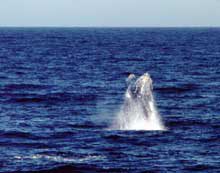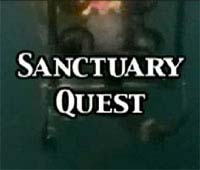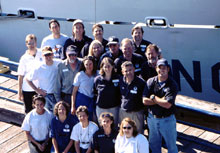
Sanctuary Quest 2002 gave us a glimpse of Olympic Coast National Marine Sanctuary's astonishing living resources. Click image for larger view.
OCNMS Sanctuary Quest: By the Numbers
June 19, 2002
Compiled by Mary Sue Brancato and Robert Steelquist, Olympic Coast National Marine Sanctuary
Preliminary research findings upon demobilization of mission:
8—The total number of Remotely Operated Vehicle (ROV) dives completed. Of these, seven were to bottom habitats, one was in the water column.
40,000 to 60,000—Estimated number sooty shearwaters observed near Swiftsure Bank (northern boundary of sanctuary) feeding in one vast raft.
Zero—The number of paleoshoreline surveys completed. Weather and equipment constraints towards the end of the research cruise forced cancellation of this groundbreaking archaeological work.
11—The total number of marine mammal and seabird survey transects completed. Ten of these were unique transects and one was a duplicate transect to correlate with trophic relationships using hydroacoustic equipment
8—The number of CTD casts completed. “CTD” stands for conductivity, temperature, depth, plus we added a fluorometer to obtain chlorophyll concentration in mg/L. These basic oceanography measurements help us understand physical dynamics of upwelling and the production of simple phytoplankton.
16—The number of stations sampled for harmful algal bloom toxins, phytoplankton species composition, and nutrient and chlorophyll levels.
2—The number of trophic relationship hydroacoustic transects lines surveyed to correlate with wildlife transects.
380—meters of depth (1200 ft.), of our deepest dive, a brief look into the Nitinat Canyon.
29—the number of different seabird species recorded. This includes the first sighting of a black tern in OCNMS. The most abundant species were sooty shearwaters and fork-tailed storm petrels.
139—number of humpback whales seen in the Sanctuary. This is the highest number recorded on a Sanctuary research cruise.
31—total number of whales photographed for individual identification. Of these, 30 were humpbacks and one was an orca.
6—the number of species of marine mammals observed. This includes 6 northern fur seals, 130 Dall's porpoises, 8 orca, 55 Pacific white-sided dolphins, 139 humpback whales, 1 minke whale and 5 unidentified whales and 18 unidentified dolphins/porpoises
Also of note:
- Using sonar mounted on the ROV we were able to detect bottom fishing trawl tracks and then observe community structure and substrate within the tracks.
- A few large gorgonian corals and sponges were seen but no assemblages.
- Numerous halibut and other flatfish observed, as well as many species of rockfish.
- A hermit crab “convention” was observed, where literally thousands of hermit crabs had convened on a flat mud seafloor.
- Seafloor substrates observed included mud, gravel, cobble and boulder fields with various associated invertebrate and fish communities.


























